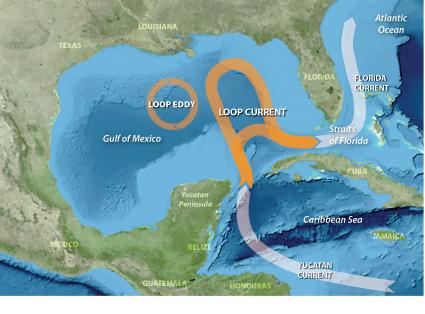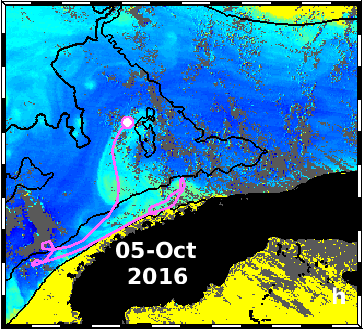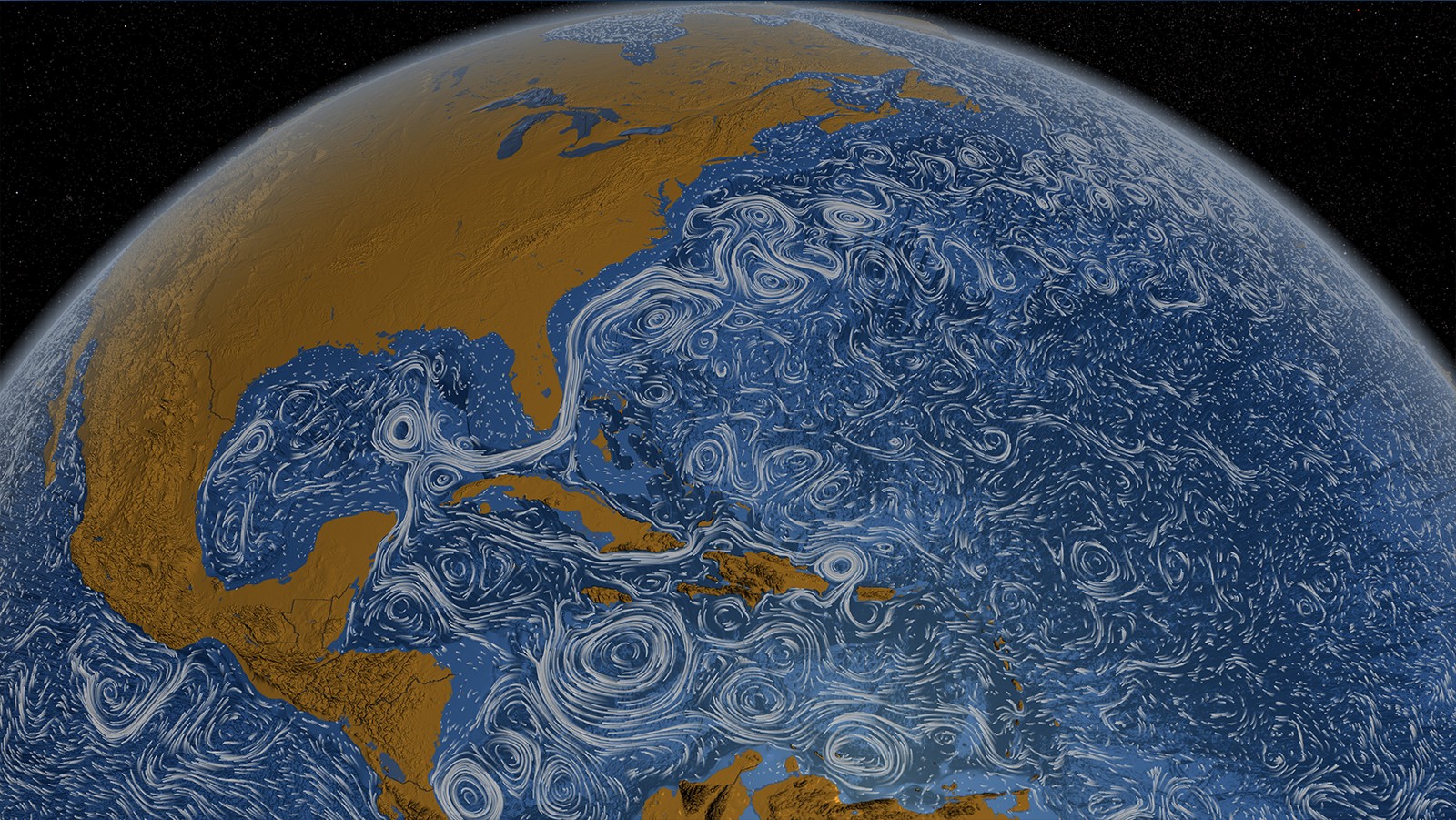Scientists at AOML in collaboration with partners at the University of Miami’s Rosenstiel School of Marine and Atmospheric Science (RSMAS) have identified Loop Current related anticyclonic eddies along the northwest coast of Cuba in the southern Gulf of America, named “CubAns” (“Cuba anticyclones”). These eddies play an important role in the ocean circulation associated with the Loop Current. This team of scientists is the first to study CubANs.
An eddy is an independent circular current of water that breaks off from an ocean current. In the northern hemisphere, anticyclonic eddies rotate clockwise and their center is often warmer than outer waters, leading to their referral as warm-core eddies. This discovery of new anticyclonic eddies has implications for how oil spills and pollution move throughout the Gulf, as well as how larval transport associated with these eddies affects fisheries populations in the region.
The Gulf of America is a semi-enclosed basin connected to the Caribbean Sea and North Atlantic Ocean. Its main dynamical feature is the Loop Current, which is a portion of the North Atlantic western boundary current that carries ocean waters from the Tropics towards higher latitudes.
The Loop Current changes its shape with time, sometimes moving directly from the Yucatan Channel (between Mexico and Cuba) to the Florida Straits (between Florida and Cuba), and sometimes growing until it forms a large loop that extends into the northern Gulf of America, near the Mississippi Delta. These different tracks are known as retracted and extended phases of the Loop Current and can be seen below. When extended, the Loop Current eventually forms a large, anticyclonic, warm-core eddy (named Loop Current Eddy) that drifts westward inside the Gulf, while the main current returns to its retracted position.

“The identification of smaller anticyclonic eddies along the coast of Cuba, named CubANs, are different from the large Loop Current Eddies and add a level of complexity to the original picture we had of the Loop Current system. We found that these CubAN eddies are connected with the shape of the Loop Current and with coastal processes,” said AOML scientist Matthieu Le Hénaff. “These eddies appear to be connected to coastal upwelling taking place along the coasts of Cuba and the associated formation of small cyclonic eddies (cold core eddies that rotate counterclockwise). When there are pairs of eddies, rotating in opposite directions of each other, they trap and transport coastal waters offshore, which is important for biological transport, or in the case of marine pollution.” This is similar to how gears in a machine work together.
Such a pair of eddies and the associated offshore transport of productive coastal waters can be seen in the satellite-derived image of Chlorophyll-a below, together with the trajectory of an ocean drifter also entrained offshore (shown in pink).

Cuban waters inside the Gulf of America are an area for oil exploration. In the case of an accidental oil spill, understanding these new processes can help scientists predict where the oil will travel.
There are also several marine protected areas along the Cuban coast that are reservoirs for biological productivity. When a pair of eddies form, larvae from these areas can be sent offshore and then transported by the Loop Current system, bringing them into the Gulf or towards Florida.
This research was a part of a Gulf of America Research Initiative project entitled “Southeastern Gulf of America processes affecting basin-wide connectivity and hydrocarbon transport: the role of mesoscale eddies and upwelling near Cuba.” As part of the project, scientists analyzed ocean observations collected in Cuban waters inside the Gulf of America during NOAA Fisheries cruises to study bluefin tuna larvae, which provided details on the structure and evolution of these ocean processes taking place along the Cuban coasts.
References:
Kourafalou, V., Androulidakis, Y., Le Hénaff, M., and Kang, H. (2017). The dynamics of Cuba anticyclones (CubANs) and interaction with the Loop Current/Florida Current system. Journal of Geophysical Research: Oceans, 122(10), 7897-7923. (https://doi.org/10.1002/2017JC012928)
Androulidakis, Y., Kourafalou, V., Hole, L.R., Le Hénaff, M., and Kang, H.-S. (2020). Pathway of oil spills from potential offshore Cuban exploration: Influence of ocean circulation. Journal of Marine Science and Engineering, 8(7):535. (https://doi.org/10.3390/jmse8070535)
Androulidakis, Y., Kourafalou, V., Le Hénaff, M., Kang, H., Ntaganou, N., & Hu, C. (2020). Gulf Stream evolution through the Straits of Florida: the role of eddies and upwelling near Cuba. Ocean Dynamics, 70(8), 1005-1032. (https://doi.org/10.1007/s10236-020-01381-5)
Le Hénaff, M., V.H. Kourafalou, Y. Androulidakis, R.H. Smith, H.-S. Kang, C. Hu, and J. Lamkin (2020). In situ measurements of circulation features influencing cross‐shelf transport around Northwest Cuba. Journal of Geophysical Research: Oceans, e2019JC015780. (https://doi.org/10.1029/2019JC015780)
Androulidakis, Y., Kourafalou, V., Le Hénaff, M., Kang, H., & Ntaganou, N. (2021). The Role of Mesoscale Dynamics over Northwestern Cuba in the Loop Current Evolution in 2010, during the Deepwater Horizon Incident. Journal of Marine Science and Engineering, 9(2), 188. (https://doi.org/10.3390/jmse9020188)
